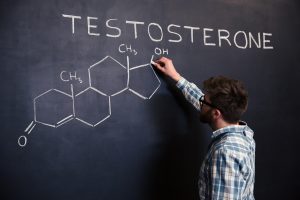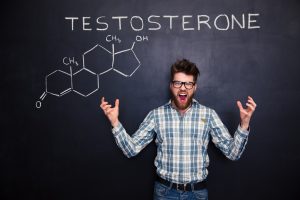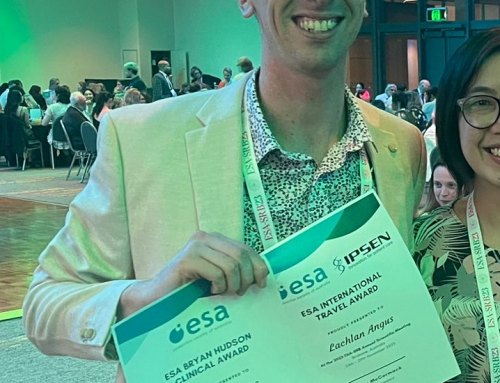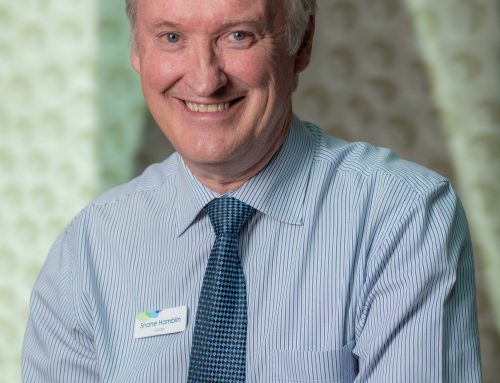 Gail Risbridger Junior Scientist Award Winner Ben Lawrence
Gail Risbridger Junior Scientist Award Winner Ben Lawrence
When he’s not cheering on the Newcastle Jets or hanging out with his black labrador Mabel, Ben Lawrence is in the lab and kicking goals with his research into the mysteries of testosterone production. “I’ve always loved biology and knowing how things work” Ben told me, but endocrinology wasn’t always on his radar.
After completing a Bachelor of Biomedical Science, he wrote his Honours thesis in the field of immunology, looking into the mechanisms of urinary tract infections in women.
While Ben observes that immunology and endocrinology don’t have too many things in common on the surface, they both investigate body-wide processes caused by interconnected phenomena that can cause devastating and complex cascading consequences. With that in mind, Ben was excited to apply for a new PhD position that had just opened up in Newcastle University’s Endocrinology Research Group looking into the interdependencies of androgen pathways.
More than one way to testosterone

Joining Ben on his journey in his exploration of these pathways are the enzymes HSD17B3 and its humble sidekick SRD5A1.
In endocrinology circles, HSD17B3 has always been seen as the star of testosterone production. Making testosterone is its job, and no other enzyme does it better.
People with XY chromosomes and a standard version of HSD17B3 develop masculine sex characteristics and go through the puberty everyone expects. However, people with a mutated version of HSD17B3 initially develop the feminine sex characteristics associated with XX chromosomes. It’s only when they reach the age of pubescence that an influx of androgens kicks in and takes them through a surprise masculinising puberty.
The unstoppable masculinity of mice
To see what was really going on, Ben and his team made some genetically modified mice. They removed the enzyme HSD17B3, which meant that the mice wouldn’t be able to make testosterone the usual way. Then they also removed the backup enzyme SRD5A1, so mice shouldn’t even have been able to make testosterone the unusual way. Previous studies had removed HSD17B3 or removed SRD5A1, but never both at the same time.
These past studies had found that when one system is down, another works to compensate for it. But no one knew which direction the mice would go when no androgen pathways were available at all.
To everyone’s surprise, these HSD17B3-less, SRD5A1-less mice, these creatures that had no known means of normal testosterone production, grew up into happy mice boys anyway. Though they showed very slight variation compared to normal mice, they had no major developmental problems.
Though the mice shouldn’t have been able to make or use a significant amount of testosterone, something mysterious was helping them do so. After confirming that the mice really didn’t have the HSD17B3 or SRD5A1 enzymes anywhere in their body, the evidence suggested Ben and the mice had discovered a third, previously unknown method of testosterone production.
Not just mice
This discovery means that HSD17B3, previously thought of as the undisputed champion of testosterone production, isn’t as important in mice as everyone had assumed. While Ben and his team aren’t entirely certain that this isn’t a biological quirk of mice specifically, if they can identify how their mice are producing their testosterone they’ll be able to begin mapping these processes and see how they might be applicable to humans. A better understanding of mouse androgen biology will allow Ben’s team to generate better mouse models for human disorders.
This discovery of the third pathway might also be able to help humans suffering from hormone disorders.
Androgen deficiency – not having enough testosterone, testosterone-like, or testosterone-precursor hormones – is a common disorder affecting millions of people, who currently have to rely on taking regular medication to manage their condition.
If a gene therapy can be developed from Ben’s discovery, teaching the body to use its own alternate pathways to produce testosterone itself could reduce dependency on current therapies and dramatically improve the lives of patients. It could also have implications for contraception and fertility treatments that use or affect androgen production.
Ben’s team is currently looking for funding for this further research.
Next steps
For Ben, winning the Endocrine Society of Australia’s Gail Risbridger Junior Scientist Award has furthered his development as a researcher in a number of ways.
Developing a mentoring relationship with Professor Risbridger has helped him expand his horizons, Ben says, as “talking to someone so experienced and having that outside perspective has been so important”.
As an early-career researcher, being recognised by his colleagues and building a name in his field is essential to applying for future grants and positions. And most importantly, it acknowledges the good work Ben has already put into this field, and means that he’ll continue contributing to endocrinology and pursuing areas of interest within the world of hormones for years to come.
 Bryan Hudson Clinical Endocrinology Award Winner Brendan Nolan
Bryan Hudson Clinical Endocrinology Award Winner Brendan Nolan
Frustrated by the lack of hard data around clinical outcomes of gender transition, Dr. Brendan Nolan decided to make his own. While trans healthcare is currently a topic of media interest, there is a surprising lack of rigorous evidence to guide practitioners in treatment. As such, the care patients receive can vary wildly depending on the doctor they see.
Putting testosterone to the test
This study works towards establishing a best practice for people living with gender dysphoria, which will help both patients seeking treatment and doctors prescribing treatments.
From his first lecture on endocrinology in medical school Brendan was hooked on hormones. However, his training as an endocrinologist only touched briefly on hormonal treatment for gender dysphoria, and once he started treating patients he found there wasn’t a lot of rigorous research to help him make decisions.
While there was a lot of anecdotal evidence from other doctors and within the trans community, hard data was hard to find.
With colleagues from The University of Melbourne, he designed a study to investigate whether it would be more beneficial for people seeking masculinising hormone therapy to receive a prescription for testosterone immediately, or wait a while before starting treatment. Plenty of research pointed to a link between beginning hormone treatment and an improvement in mental health, but these tended to be observational rather than experimental.
And unlike the majority of other studies in this area, Brendan’s had a randomised control group.
Methods and results
Participants in Brendan’s research were either given a prescription for testosterone at their first appointment, or asked to wait 3 months before receiving one. This length of time – 3 months – was chosen as it helped differentiate the two cohorts enough without causing excessive stress on the control group, but also represents an ordinary waiting time to see a specialist for this kind of treatment.
The results were clear, strong, and completely expected – the group who had started the medication earlier reported a significant reduction in gender dysphoria, depression, and suicidality compared to the control group.
In particular, of the people who had reported suicidal thoughts before treatment, 50% reported a completely turnaround after treatment. The patients who had faster access to hormones showed significant improvement in their mental health, while the patients who were asked to wait did not.
The resounding conclusion from this study is that hormones can be life-saving medicine, and that people wanting testosterone therapy for gender transition should probably just get it.
Transforming trans healthcare

As well as providing rigorous data, this study has broad implications for the field of trans healthcare. For people who can’t make their own testosterone, until Ben Lawrence gets his show on the road, they have to ask a doctor to prescribe it. And doctors who know enough about trans health to be confident prescribing serious hormones are few and far between.
This means that patients are often on waiting lists for months to see a specialist – and if the doctor then insists on a cooling-off period, they face even more waiting.
This study demonstrates that patients would significantly benefit from being treated right away.
Future work
Dr Nolan hopes to continue this line of research to follow a larger group of people over a prolonged period of time to observe the long-term effects of early access to hormones on mental health.
He’s also interested whether the same results would be seen if patients were given low-dose testosterone – an area in which very little research has been done.
Receiving the Endocrine Society of Australia’s Bryan Hudson Clinical Endocrinology Award for the presentation of this research at the Annual Scientific Meeting of the ESA means a few things to Brendan.
Firstly, it recognises his engaging style and adept science communication skills, and the development of these talents since he finished as a finalist for the same award in 2016.
Importantly, it acknowledges the importance of study in this area, and also establishes trans research as something worth doing and listening to.
This particular study was the first of its kind, and it was the first time a presentation on trans healthcare had won this particular award, so while Dr Nolan is grateful for the opportunity to share his findings with his colleagues, he hopes it’s only the beginning.


 Gail Risbridger Junior Scientist Award Winner Ben Lawrence
Gail Risbridger Junior Scientist Award Winner Ben Lawrence



